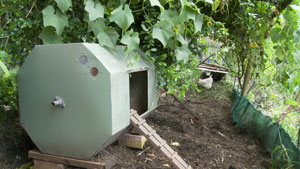Deep Litter Chicken Coops
Trying to see Anne Wensley’s chicken coop is hard to spot at first. Thats because it doesn’t really look like a traditional chicken coop. Anne has a mass of vines and creepers covering her chicken run in her suburban backyard. A choko vine covered in fruit drips off the sides of the chicken wire mesh that enclose her chicken or chook pen.
Nothing is as it seems in her garden. A large metal compost tumbler has found a new life as a makeshift chicken nesting box. Anne has no need for a compost tumbler as the floor of the chicken coop is her compost processing centre.
We are here filming with Elisabeth Fekonia the start of our Permaculture Chickens DVD and Elisabeth was quick to point out Anne’s great system that we had to see and film.
Everything is draped in dappled sunlight. Her suburban backyard is covered with vegetable plants and her chicken coop is placed center stage in the backyard, perched higher on a slope overlooking her home which is less than 30 feet away.
When you enter her coop, the chickens are hard to spot at first and are well hidden amongst the foliage. Your feet sink into the deep brown composted soil and you forget that you are standing in a chicken coop. For a moment you feel guilty that you are stepping into a heavily mulched rich garden bed. This coop doesn’t resemble the traditional hard compacted pan-baked soil you normally find in most backyard chicken coops.
Anne is a committed to Permaculture and its only when you spend a little time with her that she explains the reasons she has various plants growing inside the chicken coop.
Fresh Fruit and Grain
She points out an Acerola cherry tree in the middle of the yard. I don’t get the significance at first, until she points out that Acerola cherrys are loaded with vitamin C, in fact they have the highest concentration of vitamin C of any fruit.
The fallen fruit is eaten by the chickens and benefit the eggs they produce. Its these little details that most people don’t notice at first that are mentioned by experienced Permaculturalists who able to point out the plant and animal associations. Sometimes it takes a while for the penny to drop and you begin to appreciate more how these subtle systems works so well in the backyard to enrich the living systems.
Anne points out a purple looking weed growing rampant on the outside of the chook yard wire fence. I hardly notice it at first, but Anne points out it’s significance.
“Thats Amaranth!” she gestures to it, “My chooks love it.”
A quick check on the health benefits of Amaranth and you realise why Anne’s chickens look so healthy. There’s more energy, protein, calcium and magnesium in a quarter cup of Amaranth grain than other grains such as wheat, rice, sweetcorn or potato.
In fact Anne nonchalantly mentions that store bought grain, the kind supplied for most backyard chickens is the last thing her chickens will want to eat, preferring to graze on the fresh grain surrounding the coop.
Other forms of grain grasses grow in the perimeter of her chicken coop. The chickens graze and prune the weeds as well.
Anne explains some of her methods for deep litter composting.
Deep Litter Chicken Coops
For a start she throws all her kitchen scraps into the coop. Shredded newspaper, weeds, anything organic goes through the chicken’s inspection lines first as they scratch and peck and turn the top layer over.
Anne likes to leave a mountain of weeds in her coop for a few weeks to rot down and then with a fork turn the whole thing over pretty much like a compost heap.
The chickens race into the center of this upturned mess that is now exposed and covered in scurrying bugs. The chickens swoop on the bugs, feasting on small insects and soil creatures that abound in the bottom layer of topsoil.
You will need to leave the heap undisturbed for at least two weeks or longer before the bugs re-assemble.
Anne picks up her garden fork and regularly turns the soil over, composting it in the process. It looks brown and friable, resembling fine potting mix.
Anne lifts a handful of the stuff up to her face and smells it. “Its beautiful.” she says, “Its a really rich earthy smell. Its lovely. It doesn’t smell of chook poo or anything like that.”
The floor of the chicken coop acts as a compost system. Adding carbon in the form of old pine shavings or shredded cardboard, old leaves and paper will speed up the decomposition process.
Anne claims that turning the compost over repeatedly with a garden fork will de-compact the soil and allow the chickens to also take ‘dust baths’ and scratch around for seeds and bugs as they manure the soil.
She has had very little problem with mites or parasites infecting her chickens using this method.











i just found this online and sooooo glad i did. iam going to use annes methods. it makes so much sense. thank you Anne.
i would wish to know more from u annes about the methods u use.hope we can link up.agricultural student